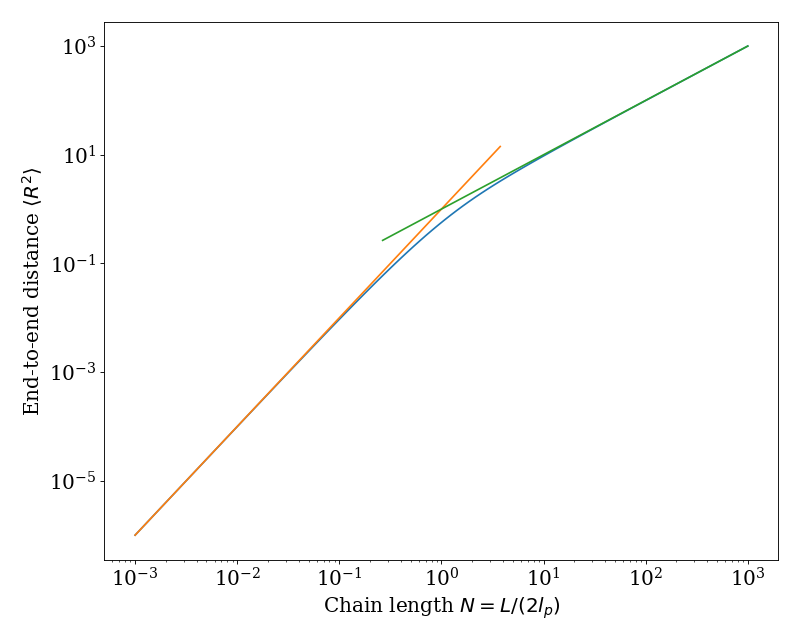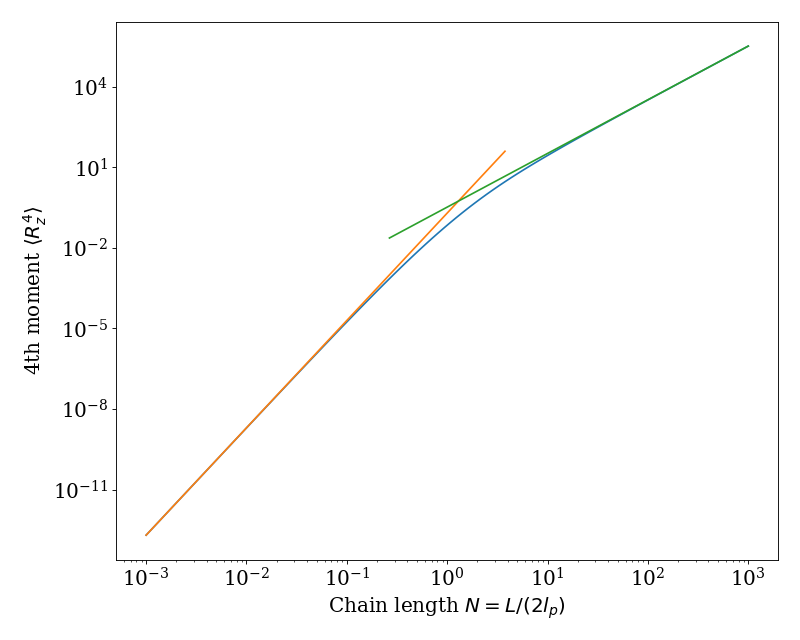Average Quantities¶
The orientation Green function can be used to evaluate any average quantity that can be expressed in terms of the tangent orientations. The Green function operates as a conditional probability, such that \(G(\vec{u}|\vec{u}_{0};L)\) gives the probability that a chain of length \(L\) with an initial tangent orientation \(\vec{u}_{0}\) will have a final tangent orientation \(\vec{u}\). We consider an arbitrary orientation-only average quantity \(A^{n} = \langle A_{n}(s_{n}) A_{n-1}(s_{n-1}) \ldots A_{1}(s_{1}) \rangle\), where \(A_{m}(s_{m})\) is a function that is expressible only in terms of the tangent orientation at arclength position \(s_{m}\). The arclength positions are ordered such that \(s_{1} < s_{2} < \ldots < s_{n-1} < s_{n}\). The average quantity \(A^{n}\) is evaluated using the following procedure:
An orientation Green function \(G(\vec{u}_{1}|\vec{u}_{0};s_{1})\) is inserted into \(A^{n}\) to propagate from the initial orientation \(\vec{u}_{0}\) at \(s=0\) to the first orientation \(\vec{u}_{1}\) at \(s_{1}\)
An orientation Green function \(G(\vec{u}_{m+1}|\vec{u}_{m};s_{m+1}-s_{m})\) is inserted into \(A^{n}\) between \(A_{m+1}\) and \(A_{m}\), resulting in a product of \(n-1\) Green functions that propagate between the internal orientations in the average
An orientation Green function \(G(\vec{u}|\vec{u}_{n};L-s_{n})\) is inserted into \(A^{n}\) to propagate from the \(n\) th orientation \(\vec{u}_{n}\) at \(s_{n}\) to the final orientation \(\vec{u}\) at \(L\)
The average \(A^{n}\) is normalized by a factor that represents the orientational integral over the full-chain Green function, i.e. the same quantity as the average without the product of \(A_{m}\)
The average is then evaluated by integrating over the orientations \(\vec{u}_{0}\), \(\vec{u}_{1}\), ldots, \(\vec{u}_{n}\), and \(\vec{u}\)
This procedure is amenable to the evaluation of arbitrary average quantities that are expressible in terms of the tangent orientations \(\vec{u}_{m}\) along the chain at positions \(s_{m}\).
For example, the average \(\langle \vec{u}(s_{2}) \cdot \vec{u}(s_{1}) \rangle\) (where \(s_{1} < s_{2}\)) is given by
where rotational symmetry implies \(\langle u^{(x)}(s_{2}) u^{(x)}(s_{1}) \rangle =\langle u^{(y)}(s_{2}) u^{(y)}(s_{1}) \rangle = \langle u^{(z)}(s_{2}) u^{(z)}(s_{1}) \rangle\) and, consequently, \(\langle \vec{u}(s_{2}) \cdot \vec{u}(s_{1}) \rangle = 3 \langle u^{(z)}(s_{2}) u^{(z)}(s_{1}) \rangle\). The normalization factor \(\mathcal{N}\) is given by
where \(u_{2}^{(z)}=\cos \theta_{2}\). Using the properties of the spherical harmonics [Arfken1999], we note that \(\cos \theta = 2 \sqrt{\pi/3} Y_{1}^{0}(\vec{u})\), and the average is written as
Integration over \(\vec{u}\) and \(\vec{u}_{0}\) force \(l_{2}=m_{2}=l_{0}=m_{0}=0\), and the subsequent integration over \(\vec{u}_{1}\) and \(\vec{u}_{2}\) result in \(l_{1}=1\) and \(m_{1}=0\). The final expression is given by
which demonstrates the role of the persistence length \(l_{p}\) as a correlation length for the tangent orientation.
This average shows that the orientation statistics can be used to directly evaluate averages that are expressed in terms of the tangent vector \(\vec{u}\). However, other average quantities can be evaluated using the orientation Green function if the quantity can be expressed in terms of the tangent orientation. For example, the mean-square end-to-end vector is written as
where \(N=L/(2 l_{p})\).
An alternative approach to calculating averages is to use the Fourier-transformed Green’s function as a generator of averages (see Refs. [Spakowitz2004], [Spakowitz2005], [Spakowitz2006], and [Mehraeen2008]. Development of this approach is provided in our discussion of the Green’s function.
The ‘wlcave.py’ module provides scripts to calculate a number of average quantities for the wormlike chain model. These include the following:
The mean-square end-to-end distance \(\langle R^{2} \rangle\)
The mean-square radius of gyration \(\langle \vec{R}_{G}^{2} \rangle\)
The 4th moment of the end-to-end distribution \(\langle R_{z}^{4} \rangle / (2 l_{p})^{4}\)
Functions contained with the ‘wlcave’ module¶
-
wlcstat.wlcave.r2_ave(length_kuhn, dimensions=3)[source]¶ r2_ave - Calculate the average end-to-end distance squared \(\langle R^{2} \rangle / (2 l_{p})^{2}\) for the wormlike chain model
- Parameters
length_kuhn (float (array)) – The length of the chain in Kuhn lengths
dimensions (int) – The number of dimensions (default to 3 dimensions)
- Returns
r2 – The mean-square end-to-end distance for the wormlike chain model (non-dimensionalized by \(2 l_{p})\)
- Return type
float (array)
Notes
See Mehraeen, et al, Phys. Rev. E, 77, 061803 (2008). (Ref [Mehraeen2008])
-
wlcstat.wlcave.rg2_ave(length_kuhn, dimensions=3)[source]¶ rg2_ave - Calculate the radius of gyration \(\langle \vec{R}_{G}^{2} \rangle / (2 l_{p})^{2}\) for the wormlike chain model
- Parameters
length_kuhn (float (array)) – The length of the chain in Kuhn lengths
dimensions (int) – The number of dimensions (default to 3 dimensions)
- Returns
rg2 – The mean-square radius of gyration for the wormlike chain model (non-dimensionalized by \(2 l_{p})\)
- Return type
float (array)
Notes
See Mehraeen, et al, Phys. Rev. E, 77, 061803 (2008). (Ref [Mehraeen2008])
-
wlcstat.wlcave.rz4_ave(length_kuhn, dimensions=3)[source]¶ rz4_ave - Calculate the 4th moment of the end-to-end distribution \(\langle R_{z}^{4} \rangle / (2 l_{p})^{4}\) for the wormlike chain model
- Parameters
length_kuhn (float (array)) – The length of the chain in Kuhn lengths
dimensions (int) – The number of dimensions (default to 3 dimensions)
- Returns
rz4 – The mean-square end-to-end distance for the wormlike chain model (non-dimensionalized by \(2 l_{p})\)
- Return type
float (array)
Notes
See Mehraeen, et al, Phys. Rev. E, 77, 061803 (2008). (Ref [Mehraeen2008])
Example usage of ‘r2_ave’¶
This example gives the mean-square end-to-end distance \(\langle R^{2} \rangle / (2 l_{p})^{2}\) (i.e. length non-dimensionalized by \(2 l_{p}\)) versus chain length \(N = L/(2 l_{p})\) for 3 dimensions. The short-length asymptotic behavior \(\langle R^{2} \rangle / (2 l_{p})^{2} \rightarrow N^{2}\) and long-length asymptotic behavior \(\langle R^{2} \rangle / (2 l_{p})^{2} \rightarrow 2 N/(d-1)\) are included to show the limiting behaviors.
(Source code, png, hires.png, pdf)

Example usage of ‘rg2_ave’¶
This example gives the mean-square radius of gyration \(\langle \vec{R}_{G}^{2} \rangle / (2 l_{p})^{2}\) (i.e. length non-dimensionalized by \(2 l_{p}\)) versus chain length \(N = L/(2 l_{p})\) for 3 dimensions. The short-length asymptotic behavior \(\langle \vec{R}_{G}^{2} \rangle / (2 l_{p})^{2} \rightarrow N^{2}/12\) and long-length asymptotic behavior \(\langle \vec{R}_{G}^{2} \rangle / (2 l_{p})^{2} \rightarrow N/[3 (d-1)]\) are included to show the limiting behaviors.
(Source code, png, hires.png, pdf)

Example usage of ‘rz4_ave’¶
This example gives the 4th moment of the end-to-end distribution \(\langle R_{z}^{4} \rangle / (2 l_{p})^{4}\) (i.e. length non-dimensionalized by \(2 l_{p}\)) versus chain length \(N = L/(2 l_{p})\) for 3 dimensions. The short-length asymptotic behavior \(\langle R_{z}^{4} \rangle / (2 l_{p})^{2} \rightarrow N^{4} 3 / [d (d + 2)]\) and long-length asymptotic behavior \(\langle R_{z}^{4} \rangle / (2 l_{p})^{2} \rightarrow 12 N^2/[d^2 (d-1)^2]\) are included to show the limiting behaviors.
(Source code, png, hires.png, pdf)
